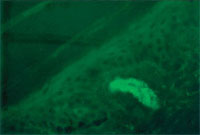|
| Fig. 3.8 Direct immunofluorescent study demonstrating granular deposits of IgA within a blood vessel of a patient with Henoch- Schönlein purpura. (Courtesy of James E. Fitzpatrick, MD.) |
Many of the immunobullous diseases are associated with specific DIF findings: bullous pemphigoid, herpes gestationis, cicatricial pemphigoid, epidermolysis bullosa acquisita, dermatitis herpetiformis, linear IgA bullous dermatosis, and the various types of pemphigus. In addition, DIF may be helpful in evaluating cutaneous and systemic lupus erythematosus, other collagen vascular diseases, vasculitis such as Henoch-Schönlein purpura (Fig. 3-8), and certain types of porphyria.
